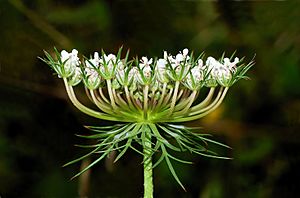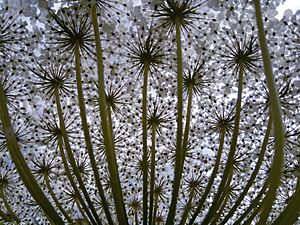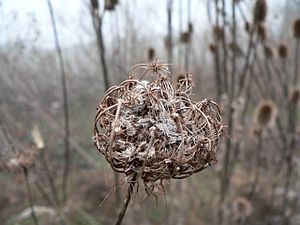Wild carrot facts for kids
Quick facts for kids Wild carrot |
|
|---|---|
 |
|
| The umbel of a wild carrot | |
| Conservation status | |
| Scientific classification | |
| Genus: |
Daucus
|
| Species: |
carota
|
The Daucus carota, also known as wild carrot or Queen Anne's lace, is a beautiful flowering plant. It belongs to the Apiaceae family, which also includes parsley and celery. This plant is originally from Europe and Asia. Over time, it has spread and now grows naturally in North America too.
Did you know that the carrots we eat are actually a special type of wild carrot? They are a cultivated version of a subspecies called Daucus carota subsp. sativus.
Contents
What Does Wild Carrot Look Like?
Wild carrot is a plant that lives for two years. This means it grows leaves in its first year and then flowers and makes seeds in its second year. It can grow quite tall, from about 30 to 120 centimeters (1 to 4 feet). The plant feels a bit hairy and has a strong, solid stem.
Its leaves are very finely divided, almost like lace, and have a triangular shape. They are about 5 to 15 centimeters (2 to 6 inches) long. The leaves grow in a pattern where smaller parts branch off a main stem.
The flowers are small and white. They grow in flat, dense clusters called umbels. These umbels are usually 8 to 15 centimeters (3 to 6 inches) wide. Sometimes, the flowers might be pink when they are still buds. You might even see a single reddish or purple flower right in the middle of the white cluster.
The plant has special leaves called bracts under its flower clusters. These bracts are usually three-forked or look like small feathers. This helps you tell wild carrot apart from other white-flowered plants in the same family.
As the seeds start to grow, the flower cluster curls inward. It becomes tighter and forms a cup-like shape. The fruits are small, dry, and bumpy. They are oval-shaped and flat, with tiny hooked spines and protective hairs.
When the fruits are dry, the whole flower cluster can break off the plant. It then rolls around like a tumbleweed, spreading its seeds. The tiny red flower in the center of the cluster is colored by something called anthocyanin. Scientists think this red spot helps attract insects to the plant. Wild carrot flowers usually bloom from May to September.
Wild Carrot vs. Poison Hemlock
Wild carrot looks a lot like a very dangerous plant called poison hemlock. It's important to know the difference!
Here's how to tell them apart:
- Wild carrot has finely divided leaves and tiny hairs on its stems and leaves.
- Its root smells like a carrot.
- It sometimes has a single dark red flower in the center of its white flower cluster.
- Poison hemlock usually has purple spots or streaks on its stems. Its stems are also smooth, without hairs.
Both plants were brought to North America by European settlers. Now, they are common wildflowers there. Always be careful and make sure you know what a plant is before you touch it or pick it!
Why the Dark Center Flower?
For a long time, people wondered why wild carrot has that tiny dark flower in the middle of its white cluster. Some thought it was just a leftover trait from long ago.
However, studies suggest it might have a special job. It could be mimicking insects, which might either keep plant-eating animals away or attract pollinators. It might signal to insects that there's food or a chance to mate.
One study found that the dark flowers attracted more varied carpet beetles. Flower clusters with more dark flowers had more beetle visits. This suggests the dark flower really does help attract insects!
How Wild Carrot is Classified
The wild carrot was first officially described by a famous scientist named Carl Linnaeus in 1753. In 2016, a group of scientists studied the complete genetic information of Daucus carota. This helps us understand the plant even better.
Different Types of Wild Carrot
All types of carrots, both wild and cultivated, belong to the same species, Daucus carota. However, there are different types, or subspecies, that have adapted to various climates.
For example, there are two main subspecies:
- Daucus carota subsp. sativus: This is the type that gives us the carrots we eat. Its roots can be many colors, like orange, yellow, or purple. They are thicker and taste sweet.
- Daucus carota subsp. carota: This is the true wild carrot. Its roots are usually white and thin. They taste bitter and are not good to eat. The center of its flower cluster is not as developed as in the cultivated type. The flower color can also vary from red to deep purple.
Where Wild Carrot Grows
Wild carrot is originally from the parts of Europe and Southwest Asia that have mild climates. It was later brought to North America and Australia.
You can often find this plant growing along roadsides and in empty fields. It grows best in places that get a lot of sun or a little bit of shade.
Is Wild Carrot Safe?
Touching the leaves of wild carrot, especially when they are wet, can sometimes cause skin irritation in some people. It's always a good idea to be careful when handling wild plants.
Wild carrot naturally produces a substance called falcarinol. This helps protect the plant from fungal diseases. While lab tests show it can be toxic to some small animals, eating normal amounts of carrots is perfectly safe for humans.
Uses of Wild Carrot
Just like the carrots you buy at the store, the root of the wild carrot can be eaten when it's very young. However, it quickly becomes too tough and woody to enjoy. The flowers can sometimes be fried, and the leaves and seeds are also edible.
Remember, wild carrot looks a lot like poison hemlock. So, be very careful and make sure you know what you're picking before you try to eat any wild plant.
If you use the flowers as a dyestuff, they can give a creamy, off-white color.
Wild carrot flowers can also be used in a fun science experiment! If you put a freshly cut wild carrot flower in colored water, the flower head will draw up the color and change its own color. This is a popular demonstration in schools to show how plants absorb water.
A Helpful Plant
Wild carrot can be a beneficial weed. This means it can be helpful to other plants when grown nearby. It's often used as a companion plant in gardens.
In its native lands, wild carrot attracts wasps with its small flowers. Wasps can help control pests. It has also been shown to help tomato plants grow better when planted close by. It can even create a cooler, moister area for lettuce when grown together.
However, in some places, like Iowa, Michigan, and Washington, wild carrot is considered a noxious weed. This means it's seen as a serious pest in farm fields because its seeds can stay in the soil for many years.
Why Carrots Can Taste Bitter
Sometimes, carrots can taste bitter. This can happen because of certain natural chemicals called metabolites.
For example, carrots might taste more bitter if they are grown near apples. Also, if carrots are stressed by something like ethylene gas, they can develop a bitter taste.
Wild Carrot in Culture
When wild carrot was brought to North America, it became known as Queen Anne's lace. There are two famous queens named Anne who might be the inspiration for this name: Anne, Queen of Great Britain, or her great-grandmother, Anne of Denmark.
The plant is called "lace" because its delicate flowers look like the fancy lace that was popular in clothing during those times. The tiny red flower in the center is said to represent a drop of blood. The story goes that Queen Anne pricked her finger with a needle while making lace.
History in Art
We can learn about the history of wild carrot and how it was grown in different parts of the world by looking at old paintings and texts. For example, paintings from the 16th and 17th centuries that show markets or farmers' crops can tell us a lot. These artworks show that yellow or red carrots were grown in Turkey, North Africa, and Spain. Later, in the 17th century, orange carrots started to be grown in the Netherlands.
See also
 In Spanish: Zanahoria para niños
In Spanish: Zanahoria para niños
- Daucus pusillus, American wild carrot





